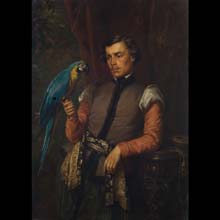
material: oil on canvas
dimensions: 45 x 32 cm
description: This allegorical portrait of a young man was inspired by Grób Agamemnona [Agamemnon’s Tomb] by Juliusz Słowacki (1839). The poem is a reminiscence of the poet’s thoughts about fame, poetry, history, homeland and the nation, and it was written under the influence of Słowacki’s trip to Greece (1836), during which the poet visited the building at that time regarded as the tomb of the king of Argos and Mycenae, the commander in chief of the Greek army during the Trojan War. In the second part of the poem, Słowacki painfully examined the Polish vices that led to the loss of independence and the failure of the November Uprising. It is a portrait of a young man in the Polish costume, staring at a parrot that he is holding in his right palm. It is a symbolic reference to Słowacki’s words addressed to the Fatherland: “You were other nations’ peacock and parrot...”. However, it would be difficult to regard this painting as an allegory of the “robust pate,” as Słowacki referred to the relics of the gentry’s obscurantism, benightedness, gluttony and intemperance, hindering new, democratic ideas, salutary for Poland. Wacława Milewska
exposition: The Gallery of 19th Century Polish Art in Sukiennice,
The Cloth Hall, 1, Main Market Square
key: Romanticism. Towards national art >>>
dimensions: 45 x 32 cm
description: This allegorical portrait of a young man was inspired by Grób Agamemnona [Agamemnon’s Tomb] by Juliusz Słowacki (1839). The poem is a reminiscence of the poet’s thoughts about fame, poetry, history, homeland and the nation, and it was written under the influence of Słowacki’s trip to Greece (1836), during which the poet visited the building at that time regarded as the tomb of the king of Argos and Mycenae, the commander in chief of the Greek army during the Trojan War. In the second part of the poem, Słowacki painfully examined the Polish vices that led to the loss of independence and the failure of the November Uprising. It is a portrait of a young man in the Polish costume, staring at a parrot that he is holding in his right palm. It is a symbolic reference to Słowacki’s words addressed to the Fatherland: “You were other nations’ peacock and parrot...”. However, it would be difficult to regard this painting as an allegory of the “robust pate,” as Słowacki referred to the relics of the gentry’s obscurantism, benightedness, gluttony and intemperance, hindering new, democratic ideas, salutary for Poland. Wacława Milewska
exposition: The Gallery of 19th Century Polish Art in Sukiennice,
The Cloth Hall, 1, Main Market Square
key: Romanticism. Towards national art >>>












